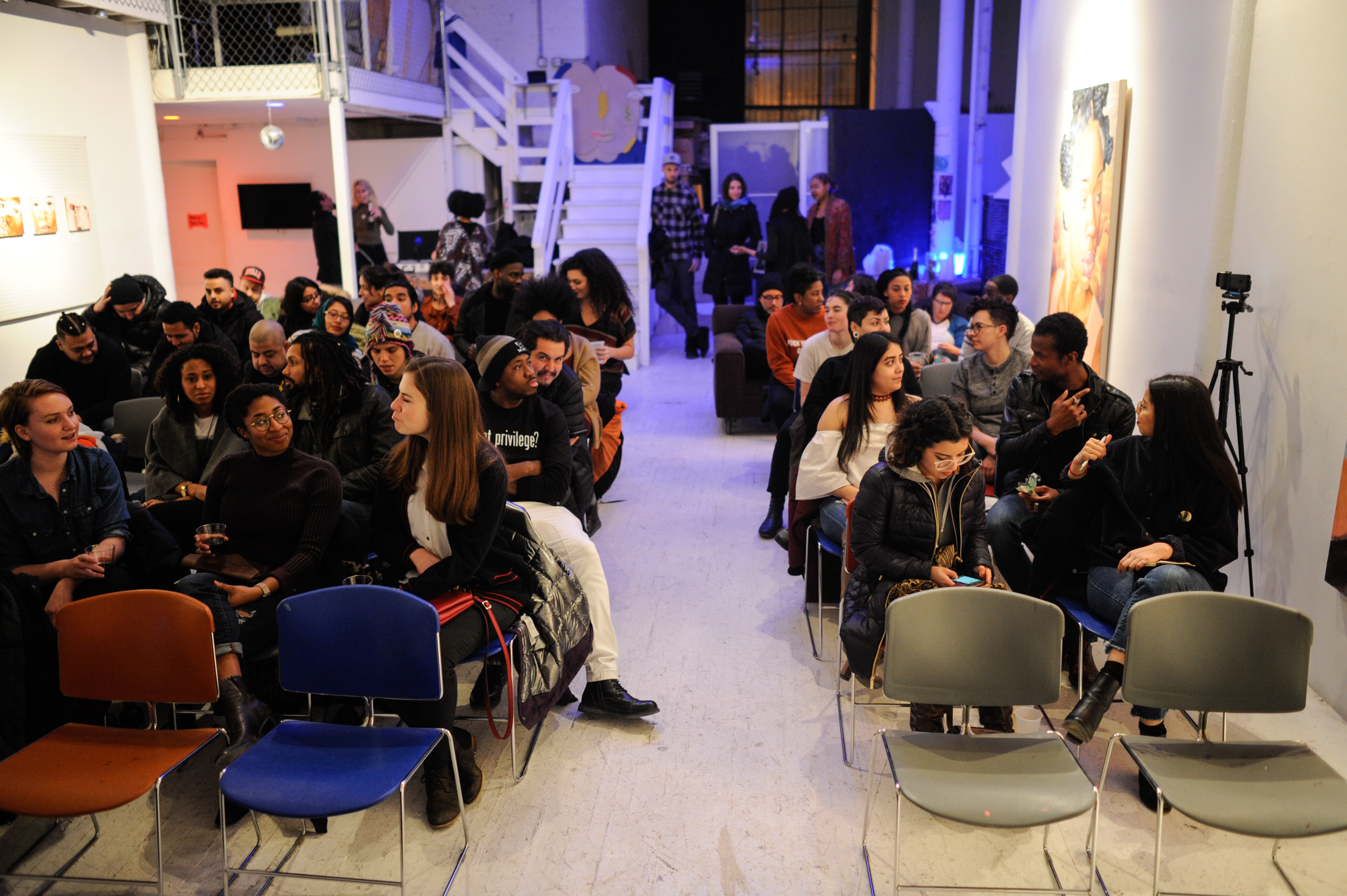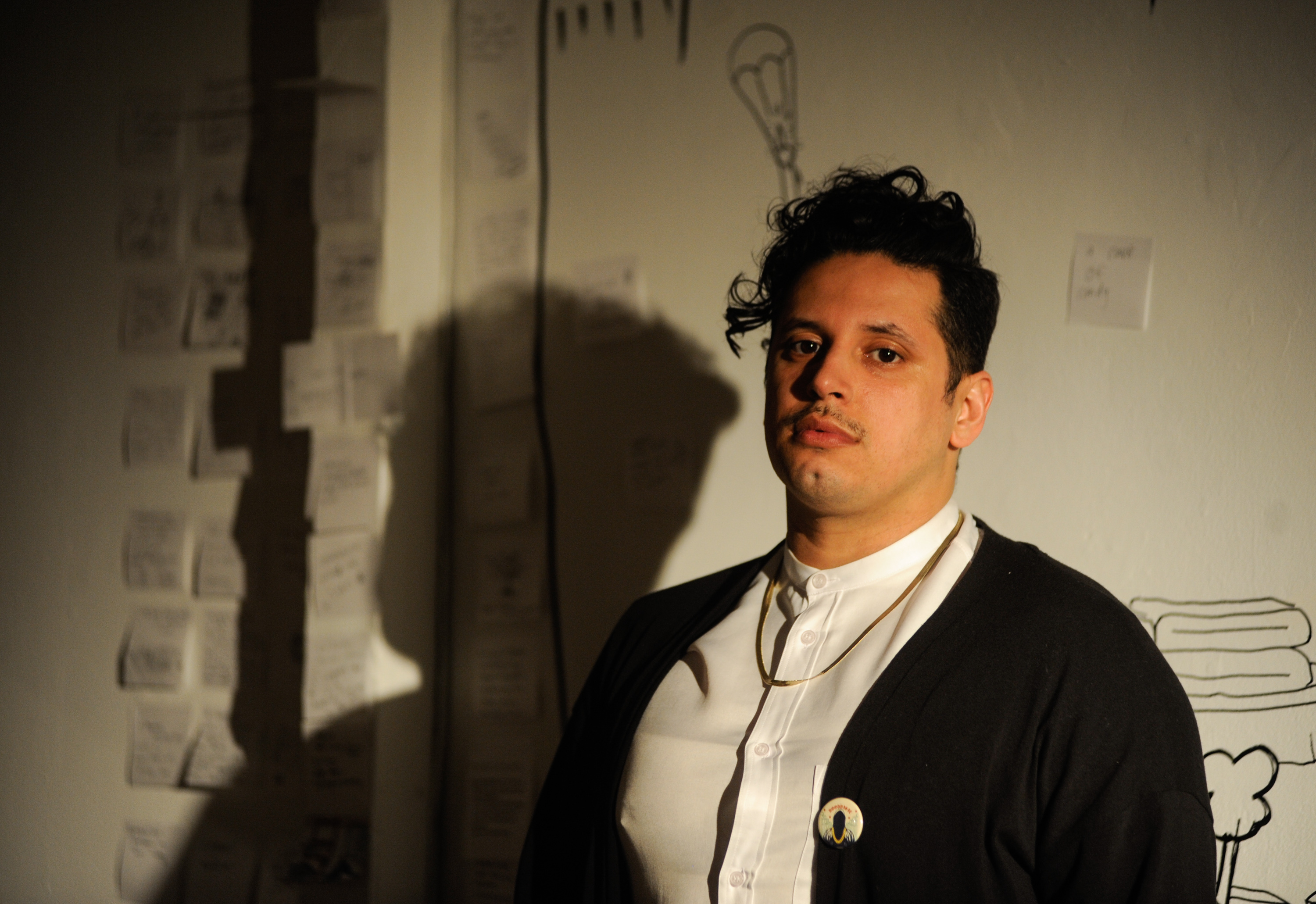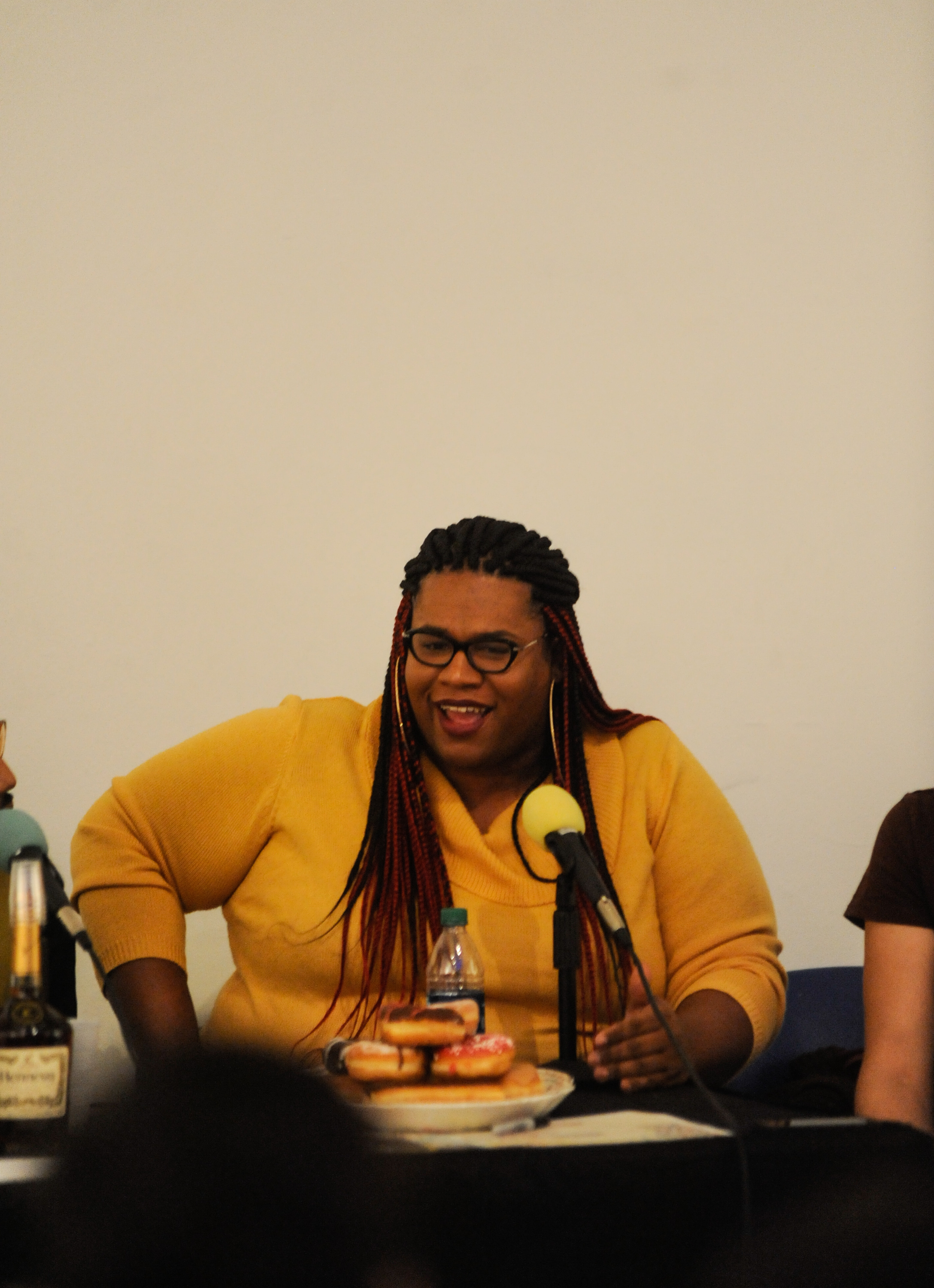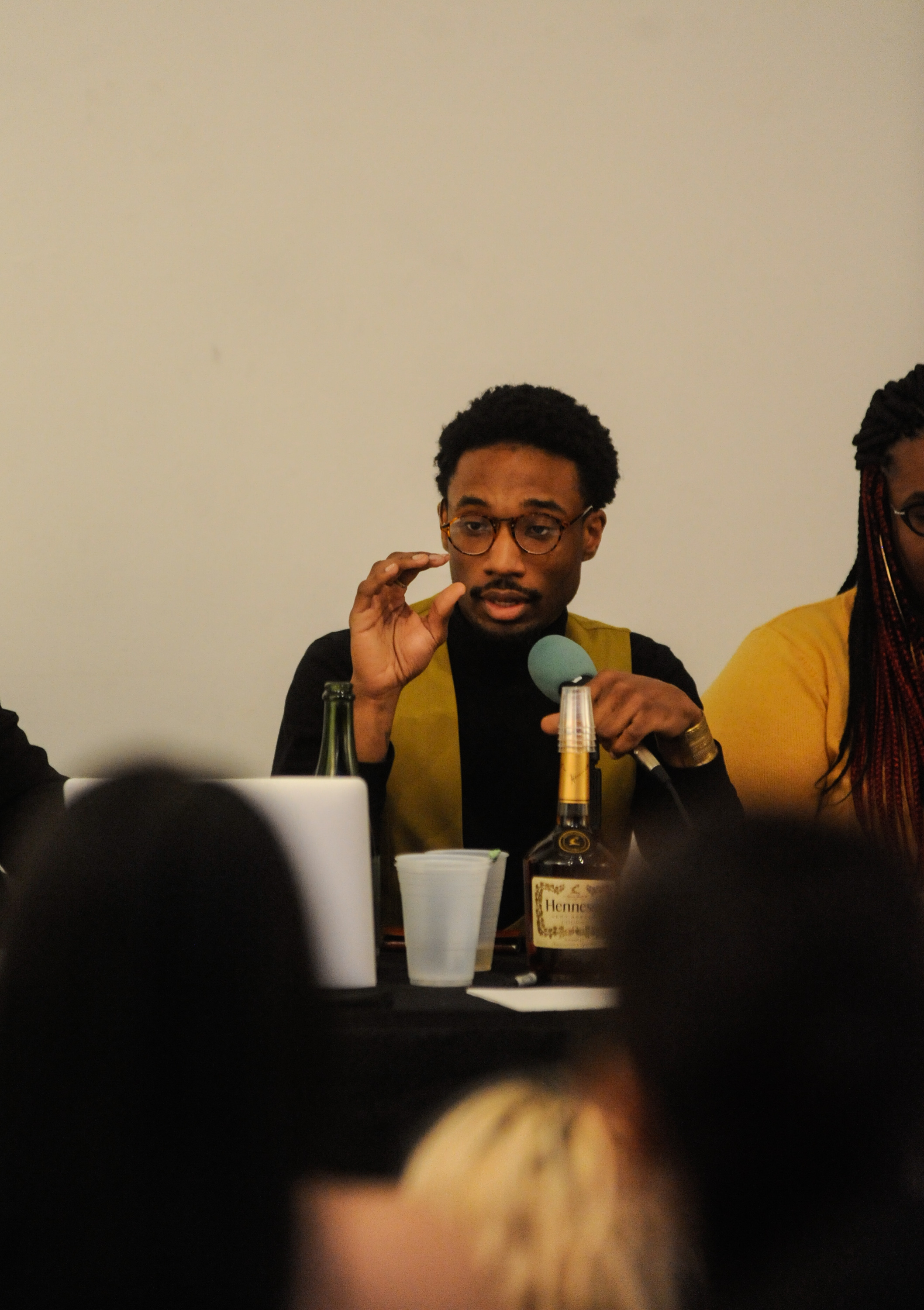Counter-Media: Live with the Hoodoisie
“Ladies and gentleman, gender non-conforming and trans deities, welcome to another episode of the Hoodoisie!” It was a Saturday night, and we sat packed-in on plastic chairs in the Chicago…

“Ladies and gentleman, gender non-conforming and trans deities, welcome to another episode of the Hoodoisie!”
It was a Saturday night, and we sat packed-in on plastic chairs in the Chicago Art Department, a Pilsen gallery. Technical issues with the sound got things off to a late start, but no one seemed to mind as they excitedly chatted with each other, embracing friends and sipping from plastic cups. When Ricardo Gamboa made the introduction, everyone cheered.
The Hoodoisie [hoo-dwa-zee, think hood plus bourgeoisie] is a live talk show that merges art, activism, and academia from what it calls “block-optic and radical perspectives.” Now in its second year, it takes place at a different cultural space in a gentrifying neighborhood in Chicago every two weeks. Each episode begins with a round table discussion of current events, called “Teatime,” followed by a more in-depth breakdown on a specific issue and an interview with a featured guest, interspersed by a musical performance. On February 3rd the featured guest was activist and educator Page May of Assata’s Daughters. A team of videographers buzzed around with smartphones, capturing the show for a livestream hosted on the Hoodoisie’s Facebook page.
The Hoodoisie is written and hosted by Gamboa, a queer, Mexican-American, Southsider, actor, director, writer, and NYU graduate student. I reiterate that list here not to define Gamboa, but to name the nodes they operate from; as they put it, their work moves with identity, but not through it. The Hoodoisie is a new kind of project for Gamboa, who recently wrote and directed the play Meet Juan(ito) Doe [read Sixty’s profile!] and the web series Brujos. The turn to a talk show format is motivated by Gamboa’s academic work and a desire to bring that discourse into a non-academic setting, one where people don’t have to take out student loans to engage.
In addition to the lively atmosphere, the Hoodoisie team installs several elements that invite audience participation. For one, an empty chair is set up at the table, open to any audience member who wants to join the conversation. This first happened during a discussion of the shortcomings of DACA and the DREAM act, when an audience member took the chair to urge people not to make light of the significance of those legislations for the survival of the individuals who received their benefits. The second time occurred during a conversation about sexual violence inflicted on women by police officers. Each time, the chair’s tenant spoke with a vulnerability that comes with feeling compelled to speak up.
The Hoodoisie works in its contradictions: its tone is heavy and humorous; academic and vulgar; serious and festive. At the beginning of the show, Gamboa told the audience that if at any point they don’t understand a term used by a co-host, they can challenge that person to define the term within the span of the Jeopardy theme song. The show’s panelists also don’t shy away from explicit language or humor. Nothing is off the table, making it at once comfortable and uncomfortable for everyone.
Gamboa and I met up for breakfast in Pilsen on the Sunday morning after the Hoodoisie. Over chilaquiles, enchiladas, and coffee, we talked about the ideologies that base the Hoodoisie and the decisions that put them into practice. Two musicians were set up in the corner, and when they were finished playing, Gamboa walked over to ask for their card. One of the musicians shared that they’d been to the Hoodoisie before and thanked Gamboa for their work in Pilsen, saying, “We see you.”

Ricardo Gamboa, host of the Hoodoisie, poses right before the start of February 3rd’s episode at the Chicago Art Department. Gamboa wears a white button-up shirt, gold chain, and black sweater with a Hoodoisie pin. Their shadow is cast on the white wall behind them. Photo by William Camargo.
Sasha Tycko: So, what was the impetus for the Hoodoisie? What was your initial intention in starting it and how did it come together?
Ricardo Gamboa: Yeah, so I think the idea is way older than when it appeared. It was a couple of things. We’re seeing stuff like the advent of these type of news shows, right? In multiple ways. The political pundits like Rush Limbaugh, and Glenn Beck, and Bill O’Reilly, and things like that. They are white men that are given these platforms to have these super conservative, hateful shows. And then you also had these liberal shows, like The Daily Show and Rachel Maddow and stuff like that. And you know, it was still always a certain type of – even with Jon Stewart, the discourse was still bound within this type of binary of liberal-or-conservative, Republican-and-Democrat. And it was still kind of white-centric. And so there was that going on. I also had grown up watching these talk shows like Oprah Winfrey and Ricki Lake. I grew up in the era of the talk show and the evening talk show. Like I loved David Letterman, I loved Jay Leno, I loved Arsenio Hall. You know what I mean? And, again, those are always cis-males on there. And all of that stuff means something, right? Because then what we’re saying is the authorities — the authorities on news, the authorities on what’s happening — are these bodies, right? Or this lens.
At the same time, I was in grad school. And thinking about that alongside being in grad school, where all this discourse that we’re reading is about marginalized people and how marginalized people got to — the degrees by which marginalized people can engage the authoring of that discourse varies. Right? And sometimes they’re not engaging it at all. They’re the subjects of study. And there’s a power dynamic there. And so part of me was like, you know, people are affected by discourse, right? Like, the university, those spaces — that’s where the data for stop-and-frisk comes out of, that justifies stop-and-frisk and all these things. So a big aspect of the project was, how do you get people to engage in discourse that affects their lives, from which they’re most often marginalized from participating in? So that was kind of the basis of the show. And then I thought about, you know, what does that mean in Chicago? And thought about something like gentrification. You know, that marginalizes people from their own neighborhoods, and also thinking about the show as this ambulatory, mobile thing, that’s inviting people to come — to engage in discourse, to engage in situations.
ST: So you have all these ideas and examples of what you’re trying to create an alternative to. What are some of the specific decisions that you have made in terms of the format and presentation of the show in order to create that alternative?
RG: Yeah. So. I mean, the first is me hosting it, right? Having a gender-queer, non-binary host — and like, brown host. And I think that matters, right? Because so much of the show deals with race, and what does that mean when a brown person is hosting an American show that addresses race so frequently, especially when the racial discourse in the United States is a binary discourse, right? Black and white. And so that’s intentional. I think aesthetically that’s very clear, right? I don’t deny any of these aspects about me. Not the Brujex, not the femme, not the hood. I mean, you’ll see me in my gold chains, dressed in black, and wearing a dress.
The other thing was to collectivize the format. The original co-hosts were Steven Beaudion and Lily Be. And then we’d have other guests co-host like that. But it was always to start modeling that there’s not just one person who has the authority to speak on the issues or that mediates the issues, right? That it’s a group of people that works through them. That it was this way of democratizing — I hate that word, “democratizing” — a way of generalizing, not exceptionalizing, you know, who’s supposed to speak, who gets to speak. Then, part of it was about making it a party. You know what I mean? So there’s always a DJ, there’s always a bar.
ST: What role does that aspect play?
RG: Because I think we live in a country where the famous maxim is you’re never supposed to talk about religion or politics. Right? And I don’t know anything else besides like, my soul, my heart, my redemption, and, like, the obstacles and the economy and the social and political circumstances that mitigate its transcendence or its imminent enjoyment, fulfillment, that is more important to talk about. For me, it’s like, what is our aversion to talking about politics or religion? What is our aversion to being in community and risking these discomforts? Because that’s what it is, right? You don’t want to make anyone uncomfortable.
And I think that that’s a very Mexican thing. Right? We party in our basements, we party in our backyards . . . People will walk in because they hear a DJ playing. You know what I mean? They see somebody hanging outside with a red plastic cup or whatever.
ST: Yeah. And it’s on a Saturday night, not on a Wednesday.
RG: And that was the other thing, too, right? Is that we were doing it as a weekend option. A viable, enjoyable, fun weekend thing, that allowed us to commiserate, while at the same time challenge and do these other things.

LaSaia Wade, a Hoodoisie co-host and trans activist, speaks into the microphone during “Teatime,” the round table segment. Wade wears a yellow sweater. Photo by William Camargo.
ST: What kind of things have you been learning from it? Or have been surprised by?
RG: That’s a great question. Because I was about to say, part of how I’ve been so careful is with who I curate to be on the show. So normally, how you curate these shows is like, you would pick who the big names are, in activism. And the biggest names. You’d try to get them on, and it’s Chicago, so they would come on. Right? And that’s not what I do. I’m like, “Who’s the activist that nobody knows about but should?” Like if someone isn’t more radical than me? You ain’t coming on my show. For me, “radical” isn’t, like, this dogmatic oppositionality, it’s getting to the root. And I think what’s so hard is we live in a time where people don’t have to embody their politics, they can just use these rhetorics to gain — especially social change rhetorics, right? — artists and entertainers are using it now, and they’re getting this currency in their career or being embraced as, like, the avant-garde of the movement, when they weren’t there for years and all of a sudden it’s cool to be a rapper that talks about social issues, it’s cool to be Beyoncé and dress up as a Black Panther at the Super Bowl, right? I’m not throwing the baby out with the bathwater and disregarding, like, wholesale what those things mean or what they could produce…. because it’s the difference between movement and trend. And trend, we know, is the commodification.
It’s like getting people on there that have a radical positionality and that negotiate from that space –
ST: Can you say what you mean by that — “radical positionality”?
RG: Yeah. I would say people that are actually trying to invest in revolution. Right? That are invested in the dismantlement of white supremacy wholesale. Dismantling of capitalism wholesale. Dismantling of nation-state as it operates as a tool of population management and subjectification and things like that, wholesale. But I do know that if we’re looking for a revolution as an event, that’s not going to happen in our lifetimes. Right? So finding somebody that’s also radical and revolutionary also means finding somebody that moves through the world radically and revolutionarily.
And yeah, the show is really forcing me to think about things around, you know, not just deeper about issues like race, but deeper about issues of, like, love. You know what I mean? Like what does radical love look like? What is really required to make social change? How is this not just a cute platform that gives me a certain type of public profile? You know what I mean? And then you have to ask — because I think I could have stopped there, right? I mean, we have a good time every two weeks, it’s great, people love the show. But I’m not satisfied with that. So right now, a lot of the questions I’m asking is like, “How does this really become a community?” And I mean a community is not just a group of people that occupy a time and space together, it’s also a group of people that do together, in communion. So how do I actionize it, weaponize this platform? How does it become a space that people know they can come to, for that type of…. for that trampolining? You know, boing!, that kind of spring! You know?
ST: Yeah, that seemed like a really consistent theme last night, specifically. Like, “building community” was something that Charles [Preston, a co-host] was talking about a lot and Page May [the featured guest] as well. So yeah, I was going to ask about that — how this, for you, functions as a community building project?
RG: It’s so hard, because it’s such a departure from everything that I do. And I’m learning as I go along, in a lot of ways, and I’m letting myself, like, be super malleable — in all sorts of cool ways. So an example is, one of the ideas with the show was that the roundtable would always be all these people that came off the street, things like that. But it’s hard to plan a show like that, that’s so unpredictable. And our featured guests would be like that. That was our first germination of it, when I first thought about what this could be. So the community-building and celebrating us, and centering us, has always been there. Actually, Gabriella Ibarra is one of the newest members of the Hoodoisie — she’s one of the youngest members, too. She’s a Mexican-American, woman, artist here, born and raised on the South Side. And she tweeted, last night, the Hoodoisie flyer. And she called it “misa del pueblo,” like “church of the people.” And I think that’s actually a good nexus that we’re operating at. Right? Because it doesn’t have a certain set of formal trappings and because it does feel like a sort of familiar basement party. Or like, as if you’re chilling with your homies. Part of why I think it’s such an effective community thing is that it encompasses this nexus of the social, the personal, the interpersonal, the cultural, the spiritual. So I would say that the community-building aspect, you know, part of it is modeling it.

Charles Alexander Preston, a Hoodoisie co-host and journalist, sits at the table holding a microphone. Preston wears glasses, a black sweater, and vest. Photo by William Camargo.
ST: You made this distinction between — sort of early on last night — between the kinds of politics that engage the political economy and the kinds of politics that are on the cultural level. You said something about how, like we can’t do that much about the political economy — I don’t know if that’s exactly what you meant, but we’re not passing policy, basically — but we can be on the cultural level of politics. I’m not sure that I’m characterizing that right.
RG: That’s right. You know, people have asked, especially with the advent of this show, like, “How come you’ve never ran for politics? How come you don’t do that?” Right? And one thing about representative government is the problem with representation that is inherent — bound inside of representation — that the thing you’re supposed to be representing can’t be there for representation to work.
So where do people self-represent? Where are people actually, then, engaging in politics every day that is in their own lives? In all sorts of ways, right? So, consumerism. You know, our fantasy of consumption — especially as leftists or radicals or things like that — is that people are just dumb as fuck and manipulated by the market. I don’t know anybody whose desires are not contoured by the social forces around them. I actually think people are, even through consumption, making critical choices all the time. Whether it’s like, “this is what I can afford” or “this is not what I can afford but I’m going to buy it anyway because it says this thing to me about me,” or things like that — you know, because you’re separated from the modes of production, so like the only thing you can do is critical consumption. And that’s how you make claims of what you want — what you buy and things like that. I think politics is a lot like that. To think about the Obama election — record young people, record people of color kept coming out to vote for this person. That might be a political victory — for the Democratic party, for Obama — but it is actually a cultural expression of a group of people being like, “This is the world we want to see.”
I think Page was alluding to this, too — I think the change that Page is trying to make isn’t necessarily just doing direct action, spectacle activism with our representatives, like with the “Bye Anita” campaign. It’s also working with the neighbor. And I think that’s kind of what I’m doing with this project and how most of my work works too. I’ve never oriented or pivoted towards talking to the “them”—“them” being power. I’ve always pivoted my career towards talking to us.
ST: Yeah, the way that I kind of see that with the Hoodoisie is how you emphasize — especially last night — emphasize the resistance narrative. With your intro last night, you started out by being like, “Okay, Trump just gave his State of the Union address. But let’s not talk about that. Let’s talk about Maxine Waters’s response and that narrative.” You can choose what you’re going to discuss, whether it’s the oppressive narrative or the resistance narrative.
RG: Yeah. Or the parallel universe narrative, right? Or trying to author a narrative from a whole different mouth, from a whole different locus of annunciation.
And I think what’s so important, too — circling back to that community-building question — this year, 2018, we added the chair that any audience member can come up to, and the audience kind of, like, shouts out questions and stuff like that, and that’s something that started happening in the last few shows. And that’s stuff that’s so welcome.
Actually, there was a student [named Ian] — a student of Isaac Gomez, a friend of mine, an actor on another project of mine, Brujos, who [taught] a theater class — who had to go and write papers about theater productions. And this student came to the Hoodoisie and wrote about it as a theater production. And it was great. And then one of the things that Ian said was like, “If this is a theater production, what genre is it? And if it’s promising to be this democratic thing, how that could be sewn into it more? Like maybe using Forum Theatre techniques by Boal or stuff like that.” I hate Boal, so no, I would not do that. But it forced me to reflect and be like, well, how do we incorporate that?
ST: More theater tactics, or just in democratic tactics in general?
RG: Incorporate our audience more, so that they get more of a participatory thing. Because if I want people to engage in public discourse — if I want the public to engage in discourse that shapes their life — how do I allow them to engage in discourse that shapes their life? Right? Like, how is the show set up for that? The ability to be able to have that chair there and be able to come up and join the conversation; the Jeopardy stuff, being able to call out when something is unclear.
You know, there’s this whole tradition of anti-intellectualism, and anti-academia, and this pretend split between community and academy. Right? The university is highly problematic and academics can be highly problematic; that’s not what I’m saying — but we get very little out of the idea that the academy is just this like, deterritorialized space that’s only about elitism, because the reality is that the biggest social movements of our lives and some of the greatest intellectuals we all revere found their safe spaces or emerged from the university, right? The student movements of the late 60s that got us ethnic studies programs. The Civil Rights movement was happening a lot on campuses, too. Audre Lorde, Angela Davis — Angela Davis was a student of Marcuse, from the Frankfurt School.
ST: I didn’t know that.
RG: Yeah. That’s her mentor. And the people who were in the university, those people, they were people from the hood and from the community that finally were getting access to higher education. And they’re super important contested spaces and viable spaces for change and radical change, too. That’s why they had to make them impossible to go to, or you had to be willing to go hundreds of thousands of dollars in debt, and qualify for those loans, so it’s a way to pacify the population, right? But the reality is, sometimes academic language can be alienating to people if it’s used, right? So then like, if that’s happening to somebody in the audience, how do we make it just like, “Yo.”
ST: What kind of action do you imagine happening outside of the Chicago Art Department, you know, when people leave that space? Like do you want people to come and then do or be a certain way?
RG: I always say, “Before we transform you, let us inform you.” I say that when we transition from the intro — after I say who the guests are going to be that night — and I say, “Before they transform you, let us inform you,” and we go into the “Teatime,” right? So, I think that’s very much the baseline. That I hope people come, they are able to access perspectives — engaged perspectives, things like that — that they might not otherwise have access to and are otherwise being given in other mainstream venues or things like that.
And I’m hoping it can be a source of movement-building that considers everything — like race, gender, sexuality, ability, right? — but that isn’t reducible to it the way that so much of our movements are. So it’s another way of thinking about social change that moves with identity, but not only through identity. So I think that’s one of the things that I’m thinking a lot about. And part of that is, how do we think alongside those questions that we need to talk about, but then also put pressure on some of our assumptions that are so easily developed and contained within identity-centered movements. Because they don’t get challenged, right? Or it’s so easy to just dismiss something.
ST: So what are some examples?
RG: I mean, I think it’s very simple. Someone could be like, “Well, you don’t get to speak on this because you’re not this.” And that type of logic came out of a really important, necessary space — sometimes people say some major fucked-up shit. But for me — you know, as a queer person, as a brown person — if a cis person or a straight person says something that I can use, then I’ll use it. You know what I mean? Or they might have an insight, right? And so I think, you know, we’re trying to create an ensemble and then an audience and performer relationship, we could say, that allows for those type of frictions to happen, and then how do we support each other through the contradictions?
ST: I want to ask about the mobility of the show. The Hoodoisie doesn’t have a home base and you don’t want to occupy stolen land — I’ve heard you say that before. Do you want to talk about the reasoning behind that?
RG: Yeah, I mean, so much of what happens is like, people do a project, a project is successful, a project gets momentum, and then people want to know how they can make that thing more and more permanent, institutionalize it more, gain more recognition, gain more success, right? And I’m not trying to do that on a show where, essentially, we’re talking about state violence and racial violence and things like that. The idea was that the show would always travel to different neighborhoods, because it’s not safe for some people to traverse across the city and through certain spaces or things like that. So we’ll bring it to you, we’ll bring the discourse to you. That’s what should be happening anyway, right? There should be a university on every block, there should be a news station on every block.
And then in somewhere like Chicago that’s highly segregated — it’s one of the most segregated cities in the country — what does it mean too, to then have this multiracial, essentially multi-generational show going around? And kind of define, like, the dictates of segregation in the city and the political economy of place in the city, and things like that. So that was a way to get and involve more people. And part of what’s happened a lot is, the will to institutionalize is the will to sediment. Right? It’s the desire to make permanent or things like that. And what does it mean to try and take up space on stolen lands, right? So I think that’s one of the things that — because I come from a different genealogy; I don’t necessarily come out of just like a Marxist, leftist genealogy that’s preoccupied with, like, class struggle between the proletariat and the bourgeoisie –
ST: By “genealogy” do you mean your own education?
RG: Yeah, my own thinking. You know, it also comes out of colonization, right? And I think that’s my larger frame. I take seriously that the United States is a settler society. Part of why the Hoodoisie is a radical platform is that we’re like, “No! This is a government that is erected on stolen land. It’s a settler society.” So we have to think about transforming it.
This interview has been edited for clarity and length.
Featured Image: An audience of roughly 50 people sits on plastic chairs in the Chicago Art Department before the February 3rd episode of the Hoodoisie. An aisle cuts through the center of the photograph, with blue lights shining from the back of the room. Art hangs on the white walls at the edges of the photograph. Photo by William Camargo.
 Starting from the proposition that art-making is world-making, Sasha Tycko combines community organizing and curatorial work with writing, music, and performance. Tycko is a founding editor of The Sick Muse zine and an administrator of the F12 Network, a DIY collective that addresses sexual violence in arts communities. Find more on IG: @t_cko and at www.nomoneynoborders.com. Photo by Julia Dratel.
Starting from the proposition that art-making is world-making, Sasha Tycko combines community organizing and curatorial work with writing, music, and performance. Tycko is a founding editor of The Sick Muse zine and an administrator of the F12 Network, a DIY collective that addresses sexual violence in arts communities. Find more on IG: @t_cko and at www.nomoneynoborders.com. Photo by Julia Dratel.
